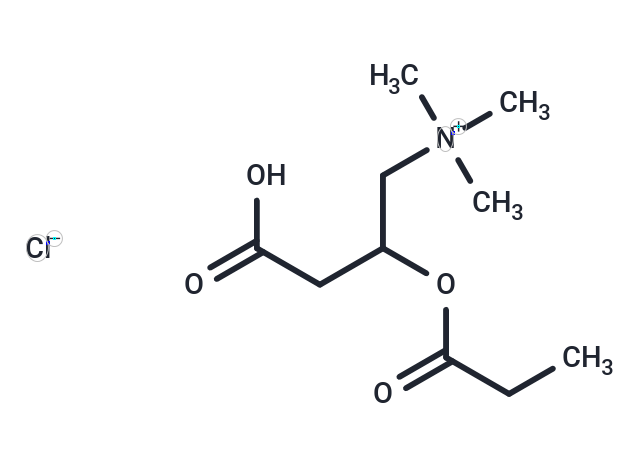Powder: -20°C for 3 years | In solvent: -80°C for 1 year


(±)-Propionylcarnitine chloride (Propionyl-DL-carnitine chloride) is a mixture of short-chain acylcarnitines used as a dietary supplement for the study of chronic diabetes.

| Pack Size | Availability | Price/USD | Quantity |
|---|---|---|---|
| 10 mg | In stock | $ 40.00 | |
| 25 mg | In stock | $ 68.00 |


| Description | (±)-Propionylcarnitine chloride (Propionyl-DL-carnitine chloride) is a mixture of short-chain acylcarnitines used as a dietary supplement for the study of chronic diabetes. |
| In vivo | In adult age-matched male C57BL/6 mice, (±)-Propionylcarnitine chloride (2 mM/kg; oral gavage; 2 mM/kg/day for 4 weeks) increased the total carnitine concentrations in plasma and urine of mice, but showed no effect on the skeletal muscle carnitine content of mice. |
| Synonyms | Propionyl-DL-carnitine chloride |
| Molecular Weight | 253.72 |
| Formula | C10H20ClNO4 |
| CAS No. | 18828-58-5 |
Powder: -20°C for 3 years | In solvent: -80°C for 1 year
DMSO: 80 mg/mL (315.31 mM), Sonification is recommended.
Methanol: 100 mg/mL (394.34 mM), Sonification is recommended.
H2O: 8 mg/mL (31.53 mM), Sonification is recommended.
You can also refer to dose conversion for different animals. More
bottom
Please see Inhibitor Handling Instructions for more frequently ask questions. Topics include: how to prepare stock solutions, how to store products, and cautions on cell-based assays & animal experiments, etc.
(±)-Propionylcarnitine chloride 18828-58-5 Metabolism Endogenous Metabolite Propionylcarnitine Chloride (±) Propionylcarnitine chloride (±)Propionylcarnitine chloride Propionyl-DL-carnitine chloride inhibitor inhibit
